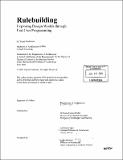Rulebuilding : exploring design worlds through end-user programming
Author(s)
Loukissas, Yanni, 1976-
DownloadFull printable version (8.944Mb)
Other Contributors
Massachusetts Institute of Technology. Dept. of Architecture.
Advisor
William Lyman Porter and Larry Sass.
Terms of use
Metadata
Show full item recordAbstract
Compositional rules have been proposed as the generating mechanisms of form in architectural treatises since Vitruvius. Recently, computational approaches to architecture have pursued a language for rulebuilding rather than the rules themselves. However, architects have resisted adopting computation as a means of expression, presumably because of the embedded culture of two-dimensional representations. A recent change in the construction industry from manual to automated fabrication techniques suggests a parallel shift in architectural representation from drawings to procedural descriptions of design. As such, computation can help architects to relate creative design to a process of manufacturing and assembly. In order to accommodate this, it is necessary to develop a new vocabulary for describing compositional rules which relies on an understanding of both design process and products as computational objects.
Description
Thesis (S.M.)--Massachusetts Institute of Technology, Dept. of Architecture, 2003. Includes bibliographical references (p. 70-71).
Date issued
2003Department
Massachusetts Institute of Technology. Department of ArchitecturePublisher
Massachusetts Institute of Technology
Keywords
Architecture.